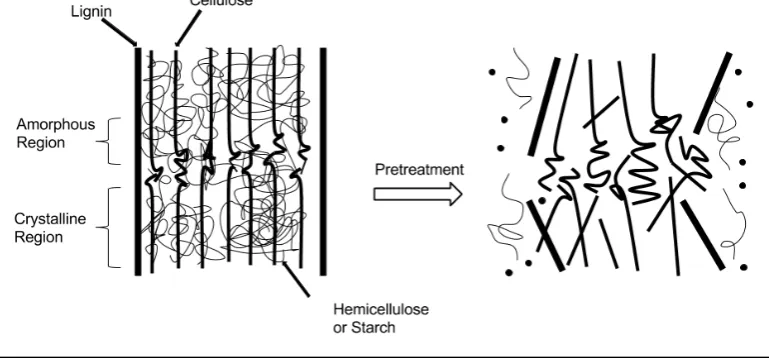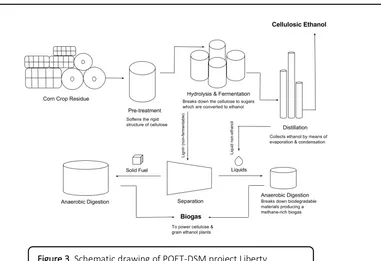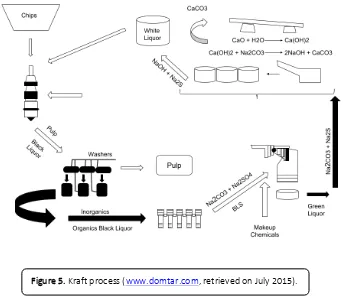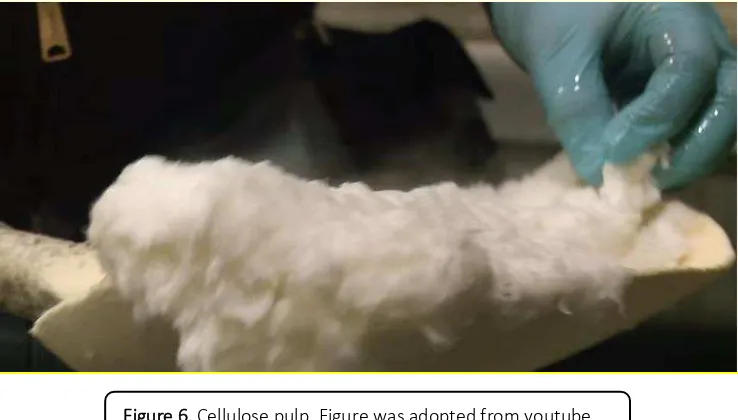Lignocellulosic Biomass Pretreatment for
Biorefinery: A Review
Zulfan Adi Putra
Chemical Engineering Department, Universiti Teknologi PETRONAS, Malaysia.
Correspondence: E-mail: [email protected]
A B S T R A C T S A R T I C L E I N F O
Lignocellulosic biomass consists of cellulose, hemicellulose, and lignin, which have the potential to produce the so-called green chemicals. Many processes are available at different scales (e.g. labs, pilots, demos, commercials), utilizing ligno-cellulosic biomass as the raw material. Due to its complicated chemical structures, lignocellulosic biomass must be pre-treated before it can be processed further. Simultaneous sep-aration of cellulose, hemicellulose, and lignin from the bio-mass is an important step to maximize the full potential of the biomass. In this review, several well-known biomass pretreat-ment technologies are evaluated. These are low pH process (e.g. dilute acid, steam explosion, hot water liquid, and con-centrated acid), high pH (e.g. NaOH, lime, NH3), organosolv, ozonolysis, CO2 explosion, and ionic liquids. The objective of this review is to understand how effective the pretreatment process for separating cellulose, hemicellulose, and lignin. Based on this review, organosolv is the only pretreatment process that is capable of separating cellulose, C5 sugars (from hemicellulose), and lignin, simultaneously. This process is currently at pilot scales of 30 – 100 ton per day of biomass feedstock.
© 2018 Tim Pengembang Jurnal UPI
Article History:
Received 11 January 2018 Revised 15 February 2018 Accepted 29 March 2018 Available online 09 April 2018 ____________________
Lignocellulosic biomass is considered as future sustainable feedstock for chemicals (Permatasari et al., 2016). It consists of three major components, namely cellulose, hemi-cellulose, and lignin (Nandiyanto et al., 2016; Nandiyanto et al., 2017). Due to their
complicated structures, the biomass must be pretreated before undergo further pro-cessing. There are already several biomass pretreatment technologies. Some of them can be categorized into mechanical and ther-mochemical processes (Cherubini, 2010). Me-chanical process aims only to reduce the size of biomass for subsequent processes.
Indonesian Journal of Science & Technology
DOI: http://dx.doi.org/10.17509/ijost.v3i1.10796 p- ISSN 2528-1410 e- ISSN 2527-8045 fraction of the biomass for subsequent
enzy-matic hydrolysis and yeast fermentation pro-cesses (Farobie & Hasanah, 2016; Bilad, 2016). The hemicellulose fraction is also sometimes used depending on the technol-ogy provider of those subsequent processes (Nandiyanto et al., 2017). Hence, it is basically
biomass; (iii) Breaking bonds between lignin and cellulose-hemicellulose via disruption of the lignin structure and dissollution of the lig-nin itself; (iv) Reduction of crystallinity of the cellulose because this crystallinity feature re-pels water. Schematically, the pretreatment in this regard is shown in Figure 1.
2. Technologies used commercially
Some commercially used pretreatment technologies are:
(i) Steam explosion technology combined with dilute acid (Advanced Steam-ExTM pro-cess) of ANDRITZ, which is used in the bioeth-anol plant of POET-DSM. The technology is shown in Figure 2. In the project Liberty (POET-DSM), sugars from both cellulose and
hemicellulose are fermented to bioethanol (http://poet.com/pr/poet-dsm-makes-major- technology-process-purchase-for-cellulosic-bio-ethanol. Retrieved on June 2015). The re-maining lignin is sent to an anaerobic diges-tion treatment to produce biogas. The biogas is used to create power to run the bioethanol plant (http://demoplants.bioenergy2020.eu/ projects/info/225, retrieved on July 2015). The schematic of the plant is shown in Figure 3.
DOI: http://dx.doi.org/10.17509/ijost.v3i1.10796 p- ISSN 2528-1410 e- ISSN 2527-8045 (ii) Steam explosion technology combined
with dilute acid developed by ENEA (Italian National Agency for New Technologies, En-ergy and Sustainable Economic Development) is also used in the bioethanol plant of Beta Re-newables, the Crescentino plant (http://www.chemicals-technology.com/pro-jects/mg-ethanol/ and http://www.enea.it /en/events/amazon_30jun14/Biomassasasou
rceofEnergy_Biofuels_Chemicals, retrieved on June 2015). Figure 4 shows the steam ex-plosion pretreatment developed by ENEA. In this particular Crescentino plant, sugars from both cellulose and hemicellulose are fer-mented to bioethanol, while lignin is used as an energy source to create power (http://www.betarenewables.com
/proesa/biorefinery, retrieved on July 2015).
Figure 2. Advanced Steam-ExTM process of ANDRITZ used in the bioethanol plant in Project Liberty POET-DSM (energybiosciencesinstitute.org, retrieved on June 2015).
DOI: http://dx.doi.org/10.17509/ijost.v3i1.10796 p- ISSN 2528-1410 e- ISSN 2527-8045 (iii) Steam pretreatment combined with dilute
am monia developed by joined technology of DuPont and NREL is probably being used in the on-going construction of a bioethanol plant of DuPont (http://biofuels.dupont.com /cellulosic-ethanol/nevada-site-ce-facility/, retrieved on June 2015).
is evaporated and then sent to a recovery boiler to produce green liquor. The green liq-uor is then treated chemically with lime to produce again the white liquor
(http://ipst.gatech.edu/faculty/ra-
gauskas_art/technical_re- views/Kraft%20Pulping%20and%20Recov-ery%20Process%20basics.pdf, retrieved on June 2015). This Kraft process is shown in Fig-ure 5. The remaining cellulose is washed and bleached and it is then called pulp. It can be seen in Figure 6. This cellulose pulp is then sent to paper manufacturing plants.
(www.iea.com , retrieved on June 2015)
DOI: http://dx.doi.org/10.17509/ijost.v3i1.10796 p- ISSN 2528-1410 e- ISSN 2527-8045 3.2. Technologies used
commer-cially
Pulp and paper making industries have ex-isted for years and there are many technol-ogy suppliers such as ANDRITZ or Metso. An improved digester (Compact Cooking G2) from Metso is shown in Figure 7.
From the black liquor, lignin has been commercially extracted with a process called LignoBoost. The technology is owned by Val-met (http://www.valmet.com/en/prod- ucts/chemical_recovery_boilers.nsf/Web- WID/WTB-090518-22575-328A1?OpenDoc-
u-ment&mid=BAD0112EAFD7623BC2257C2B0 03A12E1, retrieved on July 2015). It has been applied i Do tar pulp ill’s site i Ply -outh, North Carolina (domtar.com, retrieved on July 2015). Lignoboost is schematically shown in Figure 8.
Figure 6. Cellulose pulp. Figure was adopted from youtube.
Figure 7. An improved digester (Compact Cooking G2) from Metso (Harmsen et al., 2010)
DOI: http://dx.doi.org/10.17509/ijost.v3i1.10796 p- ISSN 2528-1410 e- ISSN 2527-8045 ozonolysis, CO2 explosion, and ionic liquids.
The objective of this review is to understand
data and the paper are free of plagiarism.
7. REFERENCES
Betarenewables.com (2015). Available online at:http://www.betarenewables.com/proesa/bi-orefinery, retrieved on July 2015.
Bilad, M. R. (2016). Module-Scale Simulation of Forward Osmosis Module-Part A&58; Plate-and-Frame. Indonesian journal of science and technology, 1(2), 249-261.
Bioenergy2020.eu (2015). Available online at:http://demoplants.bioenergy2020.eu/pro-jects/info/225, retrieved on July 2015.
biorefineries.com (2015). Available online at: http://www.iea-bioenergy.task42-
biorefineries.com/upload_mm/5/0/1/6191bfee-277e-449c-8458-8168fe31894f_de_bari_italy_country_report_2014.pdf, retrieved on June 2015.
chemicals-technology.com (2015). Available online at:http://www.chemicals-technol-ogy.com/projects/mg-ethanol/, retrieved on June 2015.
Cherubini, F. (2010). The biorefinery concept: using biomass instead of oil for producing energy and chemicals. Energy conversion and management, 51(7), 1412-1421.
domtar.com (2015). Available online at:http://www.domtar.com/en/pulp/lignin/10607.asp, retrieved on July 2015.
Dupont.com (2015). Available online at: http://biofuels.dupont.com/cellulosic-ethanol/nevada-site-ce-facility/, retrieved on June 2015
Enea.it (2015). Available online at:http://www.enea.it/en/events/amazon_30jun14/Biomassa-sasourceofEnergy_Biofuels_Chemicals, retrieved on June 2015.
Energybiosciencesinstitute.org (2015). Available online at:http://www.energybiosciencesinsti-tute.org/media/Pschorn3.pdf, retrieved on June 2015
DOI: http://dx.doi.org/10.17509/ijost.v3i1.10796 p- ISSN 2528-1410 e- ISSN 2527-8045
Harmsen, P. F. H., Huijgen, W., Bermudez, L., & Bakker, R. (2010). Literature review of physical and chemical pretreatment processes for lignocellulosic biomass, ECN, 2010, 1184.
Ipst.gatech.edu (2015). Available online at:http://ipst.gatech.edu/faculty/ragauskas_art/tech-nical_reviews/Kraft%20Pulping%20and%20Recovery%20Process%20basics.pdf, retrieved on June 2015.
Nandiyanto, A. B. D., Permatasari, N., Sucahya, T. N., Abdullah, A. G., & Hasanah, L. (2017). Synthesis of Potassium Silicate Nanoparticles from Rice Straw Ash Using a Flame-as-sisted Spray-pyrolysis Method. IOP Conference Series: Materials Science and Engineer-ing, 180(1), p. 012133).
Nandiyanto, A. B. D., Rahman, T., Fadhlulloh, M. A., Abdullah, A. G., Hamidah, I., and Mulyanti, B. (2016). Synthesis of silica particles from rice straw waste using a simple extraction method. IOP Conference Series: Materials Science and Engineering, 128(1), 012040).
Permatasari, N., Sucahya, T. N., & Nandiyanto, A. B. D. (2016). Agricultural Wastes as a Source of Silica Material. Indonesian journal of science and technology, 1(1), 82-106.
Poet.com (2015). Available online at:http://poet.com/pr/poet-dsm-makes-major-technology-process-purchase-for-cellulosic-bio-ethanol. Retrieved on June 2015.
Valmet.com (2015). Available online at:http://www.valmet.com/en/products/chemical_recov-



